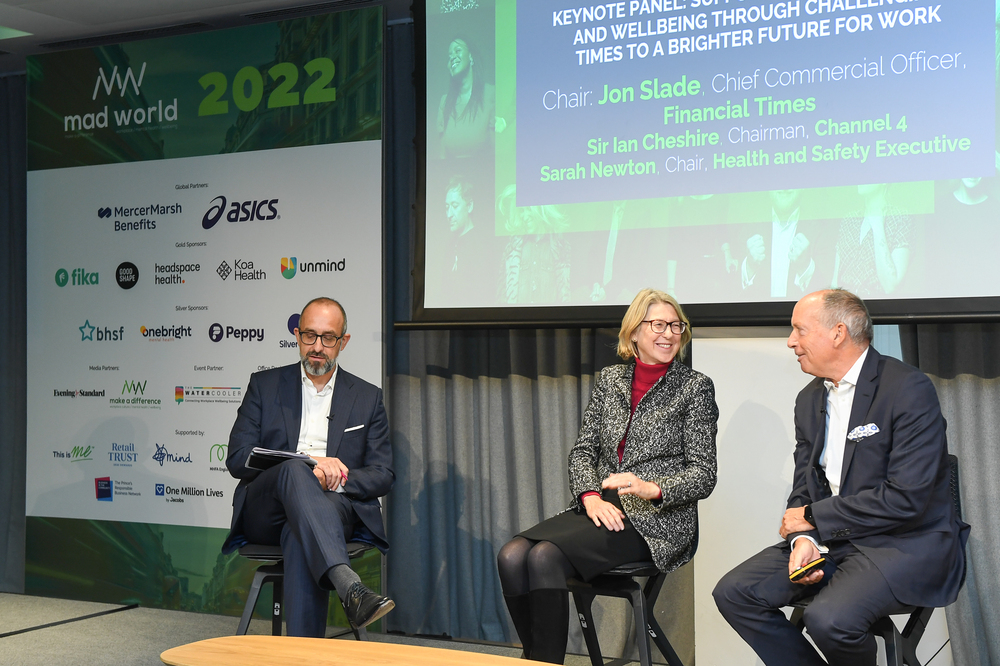Collaboration was one of the hottest topics to emerge from the 5th Mad World Summit, which took place on Tuesday 11 October, reflecting that now the wellbeing function is well established, the big challenge is embedding strategies across organisations and sectors.
Sarah Newton, chair of the Health and Safety Executive (HSE), kicked off proceedings by putting collaboration firmly on the agenda in her opening keynote panel. She took pains to stress that the HSE wants to take a collaborative approach to tackling wellbeing in the workplace – as outlined in its ‘Protecting People and Places’ strategy for 2022 to 2032 – but, if companies don’t play ball, there will be damaging consequences:
A stark warning from the HSE
“We much prefer to work with people and collaborate to persuade and encourage people to do the right thing, that’s better for everyone. But while we very much want to encourage, educate and provide all the tools to people, it’s important that employers understand they have a duty. This isn’t a ‘nice to do’, it is actually something they have a responsibility to do and if the HSE had to take some enforcement action it would be very damaging to the reputation of the organisation and very costly. In the worst cases, there are custodial sentences; it is a criminal offence for directors of companies and people do need to have that in the back of their minds.”
She also urged companies to work together with others in their sector and join the Working Minds campaign to share best practice and “support each other in industry sectors as they raise awareness and tackle these issues together”.
Sector cooperation is key
Her co-panellist Sir Ian Cheshire, chairman, Channel 4 agreed adding that “sector cooperation is really key”. As did many other speakers throughout the day, such as Catherine de la Poer, founder of Halcyon Coaching and adjunct professor of Hult Interational Business School, who said: “the imperative is knowledge sharing with other organisations about what’s working and what’s not working to drive better outcomes.”
MAD World proved the perfect setting to cultivate cross-sector contacts, especially during the many roundtable discussions designed to get professionals sharing their struggles and solutions in a more informal environment. Robert Manson, head of occupational health and wellbeing, RWE Generation, said of his discussions on ‘What does successful workplace wellbeing look like?’: “We had a full table and it was a lively discussion. There was great collaboration and lots of shared ideas and common themes. We agreed to keep in touch via LinkedIn to keep the connections going forward.”
The power of sharing real, raw stories
Jade Stanley, global lead for Spotify’s Heart & Soul content and advertising (the name it gives to its longterm strategy for mental health and emotional wellbeing) shared that one of the most powerful and effective initiatives she’s done was getting a panel of employees, at all different levels including the most senior, to share their stories together:
“This was an absolute career highlight for me. They talked about everything from suicidal thoughts to eating disorders, really big topics, that traditionally aren’t mentioned in the workplace. Some people were speaking about these topics for the first time ever. After that panel, it was just different. People were suddenly opening up a bit more. Sharing stories, which actually doesn’t cost anything other than a big vulnerability hangover for people that do share, is the biggest tip I can give.”
Culture is a collective effort
This tip was in line with what Dr Nick Taylor, founder of Unmind, advised in his session called ‘Measure it, manage it’, when he said “no one person or group is responsible for creating the culture to flourish, it’s a collective effort”. It also echoed what many other speakers said throughout the day about the vital importance of getting senior management actively involved and taking part in the conversation.
But as other sessions revealed, it can be very tricky and challenging to get this senior management buy-in, which means culture change is difficult and that wellbeing risks being seen as periphery. Paul Hendry, global VP for HSE at Jacobs, recommended speaking the language of the c-suite to get them on side saying “have your numbers and talk about the return on investment”.
“You can make the moral argument but some people might not get it,” he said. “ Finance isn’t finite. It’s about telling that story in a way that brings them on board.” He also talked about the importance of language generally, saying that his CEO and CFO had both been on the internal training to be positive mental health champions, so had a shared wellbeing language with employees.
The importance of a shared wellbeing language
Yulia O’Mahony, global head of health and resilience at Philip Morris International, agreed about the importance of a shared language – especially pertinent at her company which encompasses 92 countries. The word ‘energy’ which works across all territories has been central to talking about wellbeing.
Another collaboration challenge that practitioners talked about openly and honestly in one roundtable was the struggle sometimes to seamlessly integrate DEI with wellbeing.
Some felt that “lumping” DEI with wellbeing didn’t work because the two disciplines require completely different skillsets. Others, like Ocado, revealed they had just joined the two functions in a bid to see if that worked better. Kerrie Smith, associate director, health and wellbeing, Mace, in her session on putting together the case for investment talked about how DEI and wellbeing “played into each other and affect each other”.
When networks compete and don’t collaborate
Another niggle that the same roundtable revealed was the fact that, sometimes, there can be competition rather than collaboration between different employee networks, which can be very introspective and siloed. The facilitator leading this discussion Lucile Kamar, head of diversity and inclusion at ITN, shared that ensuring “having good regular comms providing the same level of information to them at once” was key to encouraging networks to collaborate.
Hannah Pearsall, head of wellbeing at Hays also touched on this in the session she facilitated on building and maintaining effective employee networks:
“We made the decision not to have a standalone ERG for wellbeing but to allow people from each respective network to self-nominate as human champions. A lot of what we’re trying to achieve is the same. We are wanting people to bring their whole selves to work and to feel good and function well in the workplace and that aligns to a lot of the aims of the employee network groups. So it is about collaborating and sure that wellbeing isn’t sitting on the side on its own but that it’s fully integrated to everything we’re trying to achieve.”
The challenge and reward of engaging line managers
Similarly, engaging and collaborating with line managers came up repeatedly during the day as a fundamental theme which too, at times, can also be tricky to achieve. Yet when achieved this is one of the most impactful drivers of positive mental health in a company. As Smith showed when showcasing Mace’s strategy, those employees who spoke to their line manager about their mental health often are four times more likely to reveal a mental health issue at work – thereby meaning early preventative action can be taken. Her data showed that there has been an 18% increase in line manager conversations about mental health since 2018 and a 10% increase in employees opening up about a mental health issue.
Ngozi Weller, director of Aurora Wellness, who facilitated the session on Specsavers fostering a culture of care, issued a rallying cry to the industry to keep collaboration at the heart of the industry going forward when she said:
“There needs to be more of that ‘spirit of the blitz’ that was demonstrated at the height of the pandemic, the kind of ‘we are all in this together’ attitude. In other words, less confrontation, and more collaboration, looking for common ground and building on that.”
Photo is of the opening keynote panel on ‘Supporting mental health and wellbeing through challenging times to a brighter future’. From left to right: Jon Slade, chief commercial officer, Financial Times, Sarah Newton, chair at the HSE, and Sir Ian Cheshire, chairman, Channel 4
You might also be interested in:












